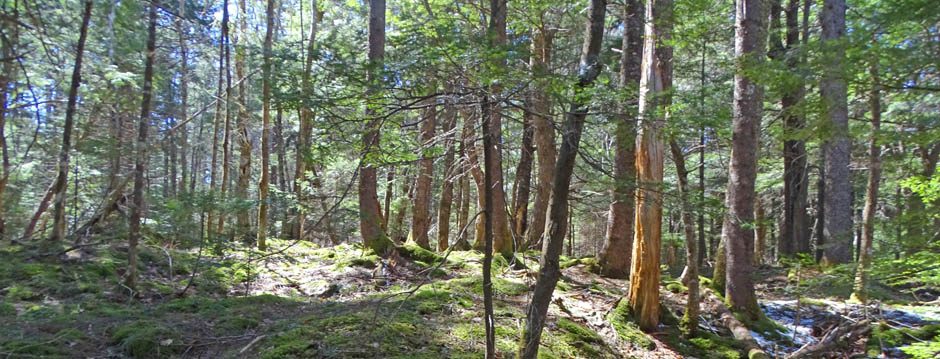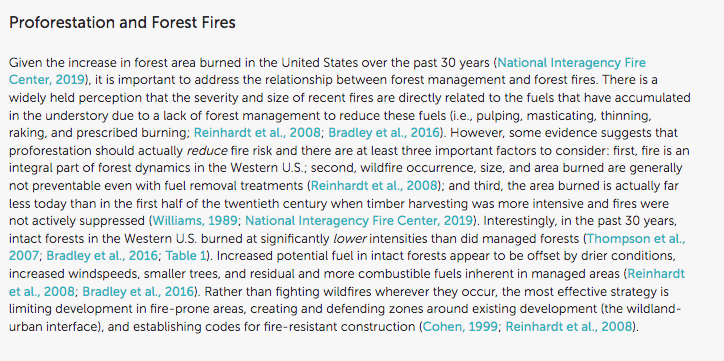Business-as-usual forestry and fire management is a burning dead end
By Julian Axmann, BC Spaces for Nature inThe Vancouver SunOctober 26, 2023 “Before wildfires got this extreme, it arguably made economic sense — from a timber production standpoint — to transform the landscape into fully stocked conifer tree farms. However, planting continuous conifer forests to address climate change is like trying to put a fire out by pouring nitroglycerin on it.Broadleaved trees provide natural fire breaks that are much needed around communities and across the commercial forest. Since deciduous and mixed forests are of little interest to the forest industry — B.C. still aerial sprays broadleaves with herbicides — serious government incentives are needed for commercial forest practices to become climate-smart. So here we are. B.C. is at a crossroads…
Wildfire management in Canada: Review, challenges and opportunities
Cordy Tymstra et al., 202) in Progress in Disaster Science “Abstract
Wildfire management agencies in Canada are at a tipping point. Presuppression and suppression costs are increasing but program budgets are not. Climate change impacts and increasing interface values-at-risk are challenging suppression effectiveness and resulting in more wildfire disasters. We conducted semi-structured interviews with these agencies to understand the strategies, policies, and preparedness procedures they currently use to manage wildfires. We summarize the results of this national agency assessment, and based on what we heard and our review of agency internal documents, discuss agency challenges and opportunities to be better prepared for a future with more wildfire. A double wildfire paradox exists requiring communities and critical values in wildfire-dependent ecosystems to be FireSmart, and wildfire management agencies to allow more wildfire on the landscape by implementing a risk-based appropriate response approach. We conclude with a proposed future path for wildfire management in Canada. To co-exist with wildfire, agencies in Canada must also strengthen and adjust their wildfire management capacity and capability. This necessitates stronger horizontal collaboration, enhanced resource sharing, investments to develop innovative decision support tools, and an increased focus on prevention and mitigation.”
Unprecedented wildfires in Canada and transboundary effects of carbon monoxide pollution
Awais Shakoor in Natural hazards, 2023. “Since March 2023, Canada has been grappling with an unprecedented succession of wildfires, which have notably intensified in June. This wildfire season has shattered previous records, making it the most severe in Canada’s documented history (Dion 2023). Furthermore, it is anticipated that Canada will experience its largest area ever affected by wildfires this year. Eleven provinces and territories, including Alberta, Nova Scotia, Ontario, and Quebec, have witnessed significant fire incidents and the subsequent detrimental effects. The repercussions of these wildfires extend far beyond the fire zones, impacting different areas hundreds of miles away, particularly cities like Toronto (Canada) and New York (United States). The effects on these urban areas are being keenly observed and experienced. Climate change, by heightening the probability of wildfires worldwide, not only places human life, wildlife, the environment, and property at serious risk but also exerts a substantial influence on air quality. The image (Fig. 1), published by European Space Agency 2023 (ESA 2023), displays the average concentration of carbon monoxide from 1 May to 13 June. The deep orange tones represent exceptionally high concentrations, primarily associated with active wildfires during that period. The image further demonstrates the dispersion of this air pollutant, reaching as far as New York in the United States and extending over the Atlantic Ocean.”
FirePred: A hybrid multi-temporal convolutional neural network model for wildfire spread prediction
Mohammad Marjani in Ecological Informatics Dec 2023. “Abstract
Wildfires represent a significant natural disaster with the potential to inflict widespread damage on both ecosystems and property. In recent years, there has been a growing interest in leveraging deep learning (DL) techniques for predicting the spread of wildfires (WS). However, existing studies have predominantly employed combined features with uniform weighting, overlooking the varying temporal resolutions they can offer (hourly, daily, and constant).As such, this study proposes a hybrid multi-temporal convolutional neural network (CNN) model called FirePred to fill this knowledge gap. In particular, 177 wildfire events were utilized along with related environmental variables between the years 2002 and 2018 in British Columbia, Canada. In pursuit of optimizing the model’s performance, an exhaustive exploration of parameter configurations and settings was conducted. This involved assessing diverse combinations of loss functions, padding sizes, batch sizes, and thresholds. Notably, this rigorous analysis yielded an exceptional F1-score of 94% utilizing the most effective parameter set. In addition, to examine the versatility of our proposed model, we conducted an assessment using a dataset encompassing 10 instances of wildfires that transpired in Alaska between 2016 and 2019, as well as a wildfire occurrence in Nova Scotia during 2023. The findings revealed that the performance of the model can be influenced by regional parameters. Finally, the implementation of an uncertainty protocol discovered that the edges of the wildfire contribute the most to the uncertainty.”
Increasing daily wildfire risk in the Acadian Forest Region of Nova Scotia, Canada, under future climate change
Ellen Whitman et al., 2015 in Nature Scientific Reports “A conceptual system dynamic model of the impact of future climate change on fire risk in the Nova Scotian Acadian Forest Region (NS AFR) was developed, clarifying the influence of positive and negative drivers of future fire risk. Weights of relative importance for seven wildfire risk drivers identified in the conceptual model were elicited through an analytical hierarchy process. Expert participants identified precipitation, temperature, and local tree species composition as the most important determinants of future fire risk. Fire weather variables collectively received a weight of relative importance of ~0.7/1. Downscaled projected climate normals of the IPCC 2.6, 4.5, and 8.5 relative concentration pathways (RCPs) were used to model daily fire weather indices of the Canadian Forest Fire Weather Index System during the fire season in the NS AFR. Daily temperature during the modelled fire season increased significantly over time, as represented by climate normals periods. No significant increase or decrease in precipitation levels was identified. Indices of fuel moisture, fire behaviour, and potential fire intensity showed significant positive trends of drying and escalation of potential severity and intensity over time under all three RCPs (p < 0.05). Though significant, increases in potential fire weather intensity were moderate overall. Given the relative importance of fire weather as a driver of fire risk, and projected increasing potential for ignition and intensity of fire, we identify a moderate potential increase in fire risk in the NS AFR under climate change.”
| Extracts from Fifty years of wildland fire science in Canadaby Sean C.P. Coogan et al. 2021. Can. J. For. Res. 51: 283–302 (References removed, bolding inserted):
“From an economic perspective, wildland fire competes with timber harvesting over much of the managed forest, causing significant uncertainty and disruption when determining sustainable harvest levels. Thus, fire suppression is strongly linked to forest management, and compelling evidence shows fire suppression reduces the area burned in intensively managed and protected forest zones in Canada. “…. Much progress has been made to assess a priori and a posteriori considerations when defining sustainable harvest levels under different fire regimes, For example, integrated forest and fire management models address complex questions and trade-offs among fire protection, timber production, and old forest conservation, yielding potential net benefits of fire management.. Salvage logging after fire is an alternate solution that has increased considerably to compensate for the loss of timber, but with negative consequences to biodiversity Projecting forward, simulations suggest that it will become even more difficult to maintain current timber harvesting levels in the future under a warmer climate and with projected increases in area burned. Compounding this problem, an emerging consequence of successful fire suppression is increased flammability of the fuel in the wildland-urban interface of communities across Canada. “Closer integration of forest and fire management is essential given their interdependencies and has become increasingly urgent as the cumulative effects of industrial forestry and fire on forested landscape biodiversity and productivity become evident. An important advance near the end of the 20th century was the widespread adoption of ecosystem-based forest management as a new paradigm for sustainability, which places greater emphasis on maintaining non-timber values and ecological integrity. In this framework, historical disturbance regime attributes provide reference conditions for ecosystem-based silviculture and ecological restoration, with fire regimes dominating many Canadian forests . For example, inspired by research on spatial patterns of fire skips, stand-scale retention of living trees in variable densities and distributions during forest harvesting is now incorporated in ecosystem-based management widely practiced in the boreal forests of Canada and internationally . However, creating landscape-scale spatial patterns consistent within the historical variation resulting from fire has proven more challenging . “Most recently, forest and fire management have shifted to emphasize resilience ‹ i.e., the capacity of an ecosystem to return to the same general structure, composition, and feedback processes following disturbance. In this context, management to reduce fire risk and hazard across a range of scales is essential for long-term sustainability of forest ecosystem function and resource management. At stand scales, uneven-aged silvicultural systems traditionally used to promote tree growth and enhance wildlife habitat are being renewed as fuel mitigation treatments to reduce wildland fire risk. Particular emphasis is placed on the wildland-urban interface, where treatments tailored to specific forest types have potential local benefits. At landscape scales, strategic location and configuration of fuel treatments aim to modify fire behaviour and mitigation of the wildland-urban interface. Across spatial scales, proactive measures include modifying forest operations and increasing prescribed burning to reduce hazardous logging residuals and regenerating forests that include deciduous species to mitigate fire hazard. Importantly, the growing recognition of the ecological benefits of fire has enabled the use of managed wildland fire, in which fires that do not threaten lives or critical infrastructure are permitted to burn within predetermined boundaries for beneficial ecological effects and cost management.” |
| Why Thinning Forests is Poor Wildfire Strategy On www.westernwatersheds.org/.”…So is there any place for forest thinning/fuel reductions? There is. But it should be limited to the areas immediately surrounding homes and communities. Since one can’t predict where a fire will start and burn, thinning forest willy-nilly is a waste of effort. Not only are most thinning projects done improperly, most are done for the wrong reasons and lose taxpayer money to boot.”No one wants houses and towns to burn up. Focusing thinning on the immediate area around structures is cost effective. It is also easier to maintain fuel reductions near homes because access is easy, and even though there are negatives with any logging operation, by focusing those impacts to the area immediately around homes and towns—places already impacted by human use—we minimize those negative ecological impacts.”Thinning trees/shrubs near homes, combined with a reduction in home flammability by installation of metal roofs, removal of flammable materials adjacent to homes, and other measures can virtually guarantee a home will survive even a severe high intensity forest fire.”Thinning forests for fuels reductions, unless strategically done, is a waste of taxpayer funds, and has significant ecological impacts. It is unwise forest policy.” |
Intact Forests in the United States: Proforestation Mitigates Climate Change and Serves the Greatest Good
William R. Moomaw et al., 2019, in Front. For. Glob. Change
Informative
Geomorphic sensitivity to fire greatest for steeply sloping terrains…
FIRE AND GEOMORPHIC PROCESSES
Frederick J. Swanson 2002 document from 1979 Conference. “ABSTRACT Fire, geomorphic processes, and landforms interact to determine natural patterns of ecosystems over landscapes. Fire alters vegetation and soil properties which change soil and sediment movement through watersheds. Landforms affect fire behavior and form firebreaks which determine burn boundaries.Geomorphic consequences of fire in a landscape-ecosystem type are determined by (a) characteristics of the fire regime,, mainly frequency and intensity; and (b) geomorphic sensitivity or erodibility of the landscape.

